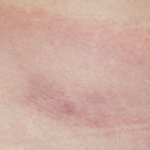As I methodically palpated Lynn’s joints, it was clear her disease had spread to involve the ankles, knees and elbows. Her knees ballooned out, stretching the tissues tightly over the kneecap. The motion in her right elbow was restricted to the point where she could barely flex the arm to comb her hair. With her wrists nearly immobile, she probably was having trouble even wiping herself after toileting.
“I’m sorry that you have rheumatoid arthritis,” I began. I turned my chair so I could alternate my attention between Lynn and her husband. I took her hands and lightly palpated the swollen fingers, then the wrists, then the elbows, knees and feet. “You have 22 swollen joints. Twenty-two. If we wait too long and damage sets in, we can’t reverse that. It’s done. The medications may sound scary but the overwhelming majority of patients I treat do well with them. We can stop the progression. We can put this disease to sleep.
“Low doses of prednisone can improve pain and swelling now,” I continued, “but it’s the slower acting medications, such as methotrexate, sometimes in combination with what we call biologic response modifiers, such as Enbrel or Remicade, that enable us to successfully manage this terrible disease.”
“Doc, she’s crying in her sleep. She had to quit her job. She can’t hold the baby,” her husband’s eyes were puffy and bloodshot.
Today, we recognize RA as an autoimmune disease. But there has always been a lingering question of whether infection might act as a triggering event for the disease. However, no persistent infection has been documented in the joints of patients with RA.
“Then I think I should inject the wrists and knees with cortisone,” I answered.
Surprisingly, Lynn silently nodded her consent. I was floored. I poked my head out the door before she could change her mind and asked my nurse, Cathy, to set up for four cortisone injections. While I gloved up and Cathy handed me a betadine swab to sterilize the skin over Lynn’s wrist, I strategized how I was going to convince Lynn to take not only prednisone but a medication with a side-effect sheet a page long, methotrexate.
Cathy chatted with Lynn about her experience as a second grade teacher. “Just count yourself lucky that you didn’t have my son,” Cathy said. “The little sneak, he pulled the seat out from behind his teacher, and she fell on her butt and had to be taken out on a stretcher. Said he saw it on a TV show.” Lynn was giggling, and I had to remind her to keep her wrist still. “My husband,” Cathy continued, “he’s a cop. I thought he was going to kill Steven. When he came home, he chased him around the house like the Gingerbread Man, but couldn’t catch the little bugger. What a scene. Now, my son is a cop. Go figure.”



